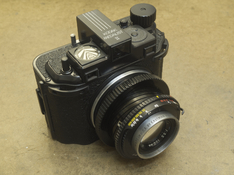Dan Daniel
Subscriber
I posted a photo of a Medalist II that I had black Cerakoted in the medium format forum. I thought I'd say a bit more about what I learned in having this done.
Cerakote is a ceramic coating that is applied to metal and then baked. It is used on guns most often. Similar to powder coating in some ways.
 www.cerakote.com
www.cerakote.com
The Cerakote material has thickness, and for a camera this buildup is not insignificant. The process is usually used on guns and the finisher I used was used to guns. I showed him assorted parts fitups and he saw no problems from applying Cerakote. Well, he was wrong. I simply threw out the Cerakoted focus helical and used the back anodized one from a first type Medalist becasue the helical was too tight and unsuable. Threads on screws needed to be cleaned up repeatedly. Fit up at joints were off. Be prepared for this. Talk with the coater to see if you can do prep work to shield threads, etc.
It is not a dust-free operation. I believe that the material is applied in a liquid base and then heated. Not like powder coating where electrostatic adhesion reduces dust.
Prep of the base involves sandblasting; well, walnust shell blasting is what they used I think. This creates masking issues as masking will simply be shredded away. Look for mechanical solutions- put screws in tubing to protect threads, for example.
From my experience, I'd guess that gun people are not looking at finish in the same way that a camera person might be. Issues of consistent coating, dust reduction, material build up mean different things to different traditions. Find a coater who will deal with your obsessive requests.
OK, now for the good: it is a strong material and coating. Not permanent and it will chip and rub down. But pretty darn strong. I think that it would be able to make a very nice end product if proper prep, application, and attention to tolerances and fit issues are handled well.
Cerakote is a ceramic coating that is applied to metal and then baked. It is used on guns most often. Similar to powder coating in some ways.
Cerakote.com - Global Leader in Thin-Film Ceramic Coatings | Cerakote
Cerakote is a global leader in the manufacturing of thin-film protective ceramic coatings. Specialized finishes for Automotive, Aerospace, Industrial, Consumer Electronics, Sports & Fitness and more. Browse our Gallery, locate a Certified Applicator, or contact us about your coating needs.
The Cerakote material has thickness, and for a camera this buildup is not insignificant. The process is usually used on guns and the finisher I used was used to guns. I showed him assorted parts fitups and he saw no problems from applying Cerakote. Well, he was wrong. I simply threw out the Cerakoted focus helical and used the back anodized one from a first type Medalist becasue the helical was too tight and unsuable. Threads on screws needed to be cleaned up repeatedly. Fit up at joints were off. Be prepared for this. Talk with the coater to see if you can do prep work to shield threads, etc.
It is not a dust-free operation. I believe that the material is applied in a liquid base and then heated. Not like powder coating where electrostatic adhesion reduces dust.
Prep of the base involves sandblasting; well, walnust shell blasting is what they used I think. This creates masking issues as masking will simply be shredded away. Look for mechanical solutions- put screws in tubing to protect threads, for example.
From my experience, I'd guess that gun people are not looking at finish in the same way that a camera person might be. Issues of consistent coating, dust reduction, material build up mean different things to different traditions. Find a coater who will deal with your obsessive requests.
OK, now for the good: it is a strong material and coating. Not permanent and it will chip and rub down. But pretty darn strong. I think that it would be able to make a very nice end product if proper prep, application, and attention to tolerances and fit issues are handled well.









 The 1940s anodizing on the helicals on the Medalist are well-done, solid (no translucency) and hold up very well.
The 1940s anodizing on the helicals on the Medalist are well-done, solid (no translucency) and hold up very well.

